Awaiting a New Tenant: Pioneer Arcade at North and Pulaski

At North and Pulaski is Pioneer Arcade, a vacant Spanish Baroque building with a long history in Humboldt Park. This faded but magnificent structure designed by Jens J. Jensen served as an entertainment venue for more than 80 years.
Before learning about this architectural treasure, let’s look at the history of the area around North Avenue and Pulaski Road.

North and Pulaski with Pioneer Bank in the background. John Morris/Chicago Patterns
The Origins of “Pioneer” at North and Pulaski
Pioneer Arcade is one of several buildings whose name was taken from Pioneer Bank, located just a few feet on the northwest southeast corner of North and Pulaski.

North and Pulaski, courtesy of Central Electric Railfans’ Association
North and Pulaski Historical Society provides more detail on the etymology:
“Pioneer” refers to the name of Pioneer Trust and Savings Bank, at the northwest corner of North and Pulaski. That name was chosen because many of the original directors and stockholders were descendants of the pioneer families who settled the Hermosa, Cragin, Galewood, and Montclare communities of Jefferson Township, before it was annexed to Chicago in 1889.
Families like the Lovetts, Rutherfords, Sayres, Merrils, Keeneys, and the Van Nattas were part of those original group of stakeholders, directors, and early bank presidents. In fact, the Lovett family first settled in the Chicago area in 1835. They traveled from New York in a covered wagon train. The covered wagon became the Pioneer Bank logo.
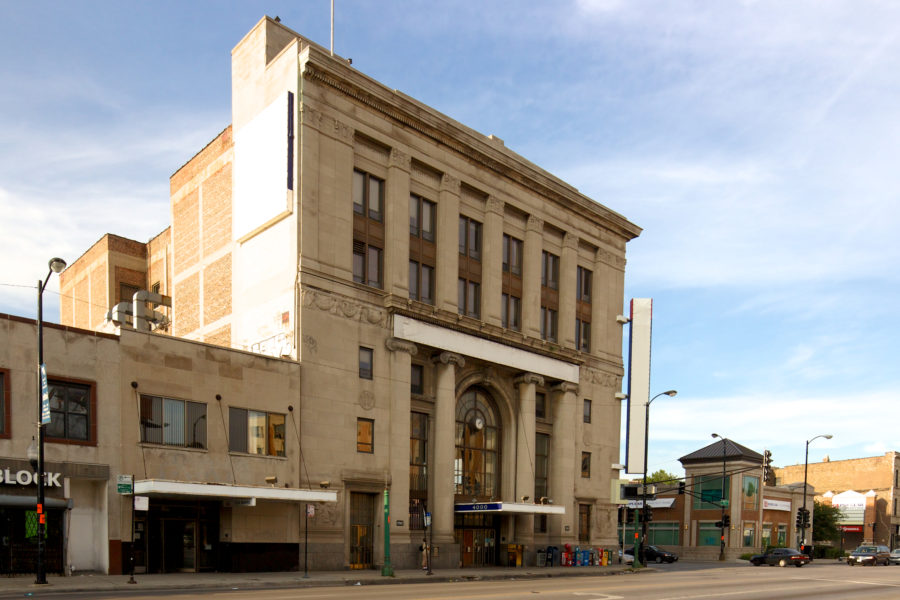
Pioneer Bank, John Morris/Chicago Patterns
Pioneer Bank, Anchor of North and Pulaski
Though it currently sits vacant, this imposing classical structure was the basis of growth for a bustling corridor, as the North and Pulaski Historical Society continues to explain:
The bank originally opened as Pioneer State Bank in 1913, but later became the Pioneer Trust and Savings Bank when the building you see today opened in 1924. The Pioneer financed the business and residential growth of the North and Pulaski community and its legacy is stamped onto many of the buildings and businesses you still see in our community.
Throughout our neighborhood’s history, more than twenty businesses or buildings have been named in respect to the financial security the Pioneer Trust and Savings Bank gave our little corner of this city.
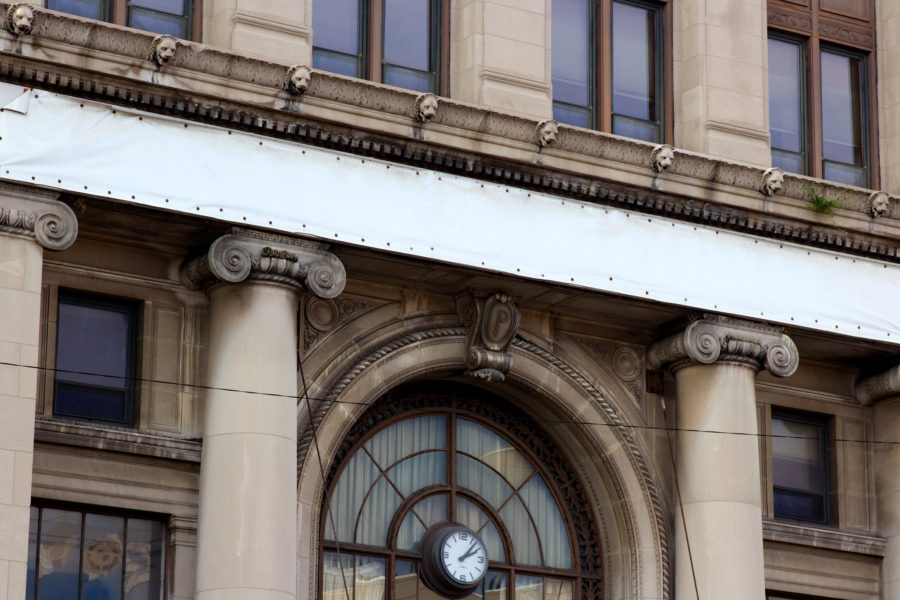
Pioneer Bank facade detail, note “P” on cartouche above arch. John Morris/Chicago Patterns
Although the architectural styles of Pioneer Bank and Pioneer Arcade are quite different, they both share a similar design element: a cartouche with the letter P, for Pioneer.
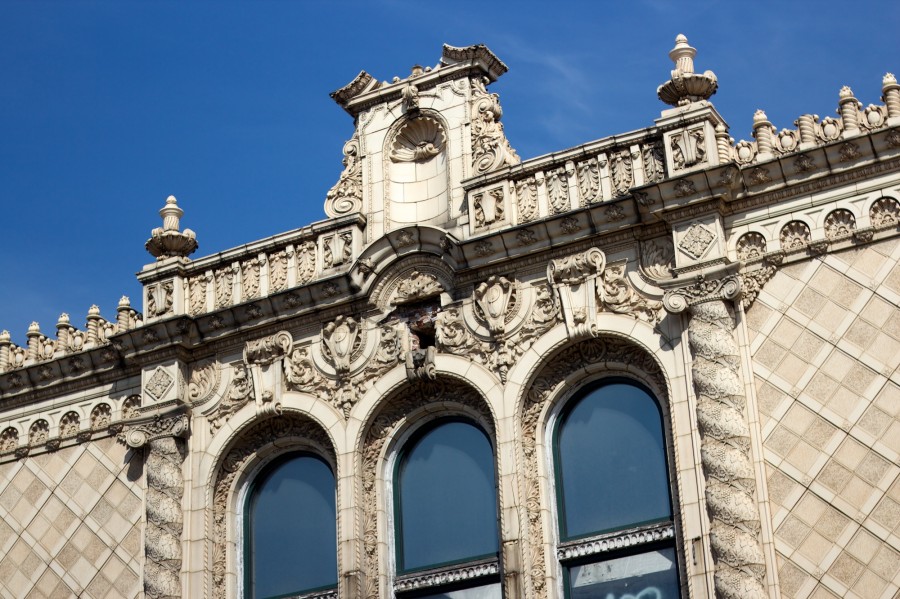
Pioneer Arcade facade detail, note dual “P” inscriptions on twin cartouches above windows. John Morris/Chicago Patterns
Jens J. Jensen (Architect), Not Jens Jensen (Landscape Architect)
The architect of this West Side jewel is Jens J. Jensen, who also designed the now-vacant Guyon Hotel at Washington and Pulaski. Not surprisingly, he’s been mistaken for another Jensen: Jens Jensen, master landscape architect who created Columbus Park and other West Side parks:
Jens J. Jensen wasn’t the only Danish-born Jens Jensen working in Chicago during the first decades of the twentieth century. He is still often confused with the great landscape architect Jens Jensen though Jens J. was of no relation and was in fact thirty years younger. Even the definitive AIA Guide to Chicago incorrectly attributes the Hotel Guyon to the elder Jensen.

Pioneer Arcade shortly after opening in 1925, image courtesy of North and Pulaski Historical Society
Churrigueresque Spanish Baroque
There are few Spanish Baroque-styled buildings in the city that are as lavishly designed as Pioneer Arcade. With heavily detailed geometry, terra cotta shells, twisted columns, and undulating cornices, it has many Churrigueresque details present in the Spanish Revival style that experienced a resurgence in the 1920s.
The Gold Dome Field House in Garfield Park is another example of a richly detailed and heavily ornamented 1920s Churrigueresque Spanish Revival design.
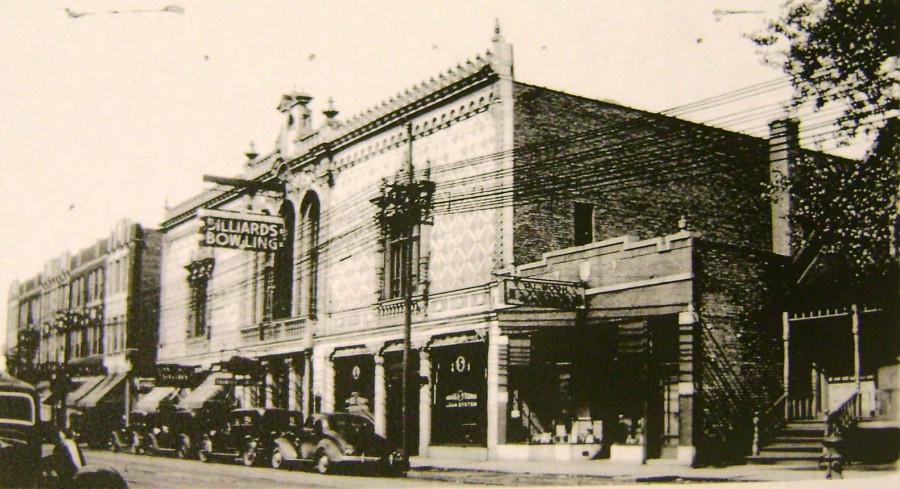
The Pioneer Arcade in 1936. Photo from the Archive of the Cook County Circuit Court Clerk, courtesy of John D. Cramer
Rise of League Bowling
The 1940s era saw a rise in league bowling, as described by Priceonomics:
Throughout the 1930s and 40s, “Beer Leagues” dominated professional bowling. The best bowlers were recruited by beer companies — Miller, Stroh’s, Budweiser — and pitted against each other in tournaments. The era’s superstars — Buzz Fazio (Stroh’s), Dick Weber (Budweiser), and like — faced off on televised events that attracted millions of viewers.

Advertisement for Pioneer from August 1961 Suburbanite Economist newspaper
Riding the Tide of Bowling’s Growing Popularity
Bowling’s popularity continued to rise in the 1960s, and Pioneer Bowl received new life in the form of resurfaced lanes around that time. This golden era continued until the 1970s:
With the rise in popularity of televised bowling and its superstars, recreational bowling also saw a boom in the 1960s: over 12,000 sanctioned alleys were constructed during the decade. The U.S. Bowling Congress peaked at 4.6 million recreational members. As one long-time “just for fun” bowler puts it: “Bowling was the thing to do back then. Every weekend, those places would be packed with kids, parents, grandparents. Everyone bowled.”
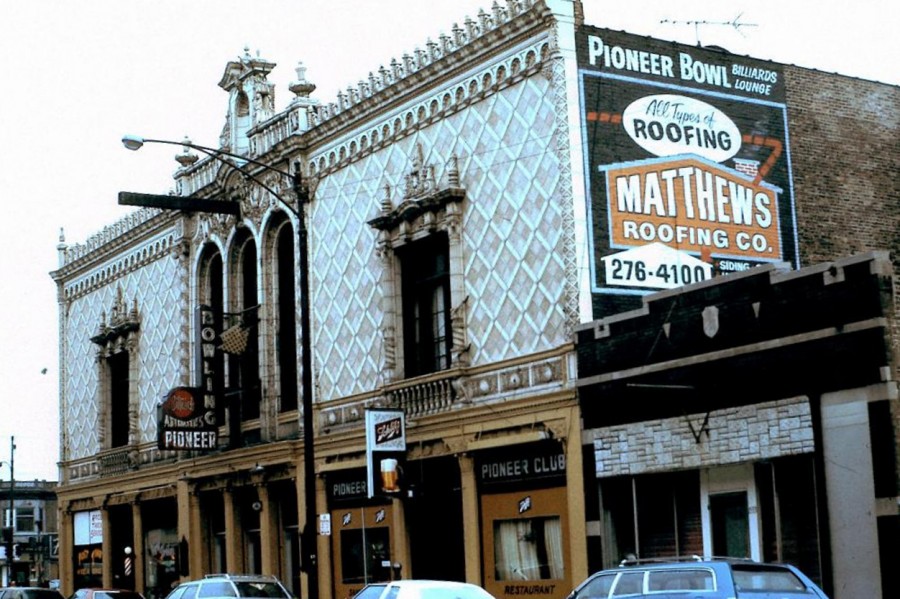
Pioneer Arcade photo by J.R. Schmidt
By the mid 1970s, bowling began to wane as a popular sport. And with it the luster of Pioneer Arcade and the neighborhood around it began to fade at the same time.
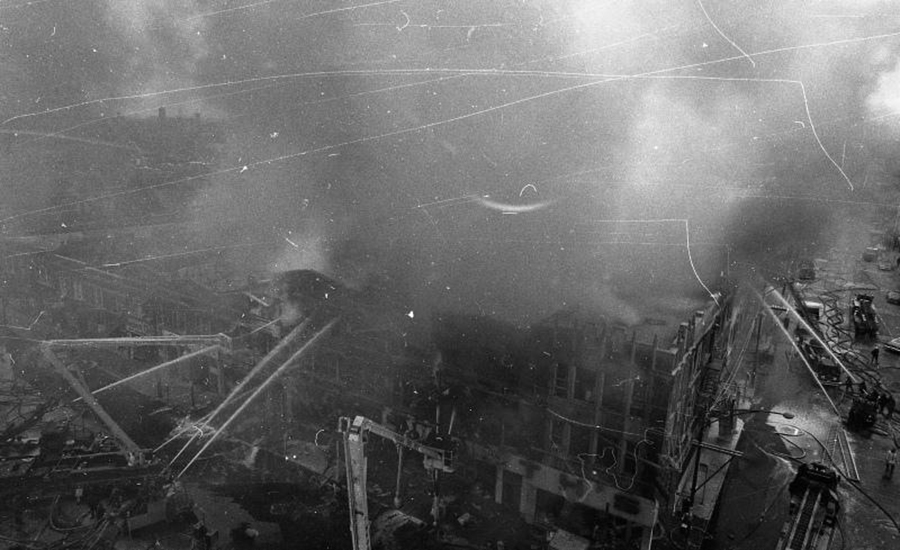
Aerial view of 1975 Woolworths fire. Photo courtesy of North and Pulaski Historical Society
Woolworths Fire
In 1975 a fire broke out in the basement of the Woolworths store on the southwest corner of North and Pulaski, leaving a gaping hole in a dense commercial district. Pioneer Arcade was not damaged by fire, but the disaster left the adjacent lot vacant for nearly 40 years.

New Apollo Theater at southwest corner of North and Pulaski, across from Pioneer Arcade. John Morris/Chicago Patterns
North and Pulaski Today
Pioneer Bank is no longer in operation and many of the once glittering theaters and ballrooms around it were demolished. A few others sit vacant like the New Apollo Theatre pictured above.
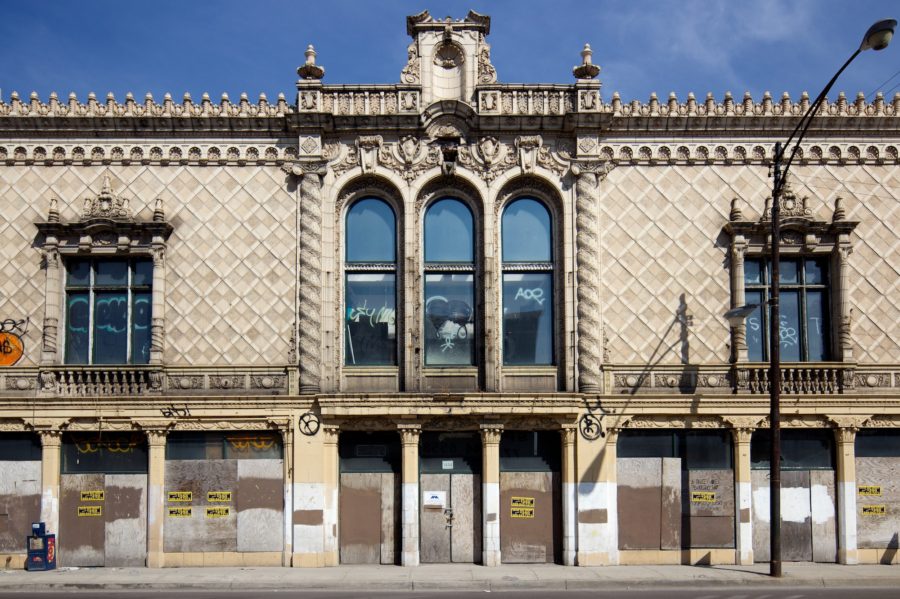
John Morris/Chicago Patterns
Fortunately Pioneer Arcade isn’t at risk, but it is vacant–the root cause of so many demolitions.

North and Pulaski senior housing development with Pioneer Arcade in the background. John Morris/Chicago Patterns
Bringing Life to an Empty Lot: Hispanic Housing Development Corporation
Over the winter, a housing development arose from an empty lot on the southeast corner of North and Pulaski. This project which is not yet complete will provide housing to seniors and retirees.
It’s the work of Hispanic Housing Development Corporation, a non-profit whose mission is to provide affordable housing in Chicago’s Latino neighborhoods.
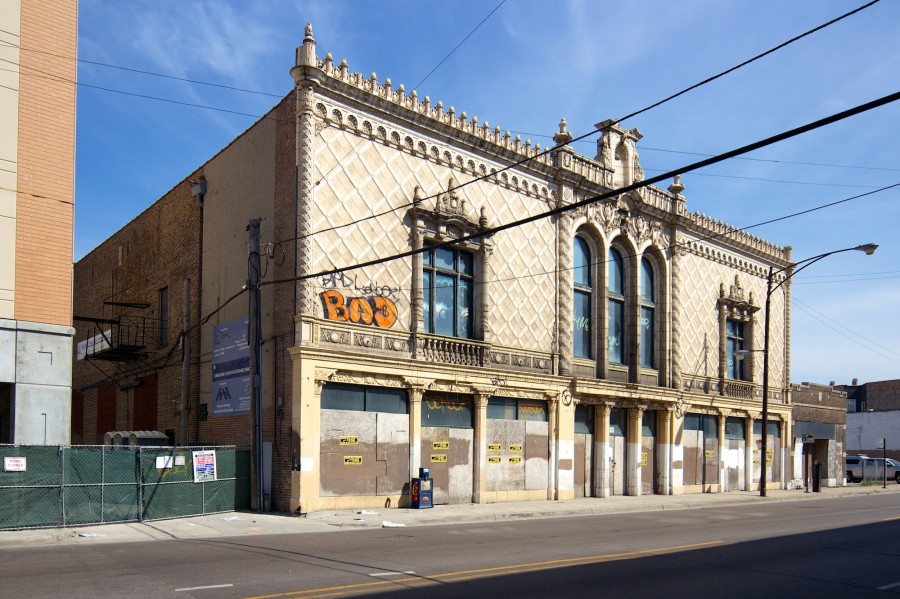
John Morris/Chicago Patterns
The Future of Pioneer Arcade
This organization also owns the adjacent Pioneer Arcade. I had a chance to speak with the President of HHDC, and was relieved to discover that his organization has a real appreciation for the importance and history of the building and there are no plans to take it down:
The Pioneer Arcade has a long history as a place of playful camaraderie for many ethnic generations in the Humboldt Park community. We hope that our new adjacent senior building will provide the development catalyst, and built-in customer base, to attract a retail or service use which will breathe new life into this grand historic structure.
— Hipolito “Paul” Roldan, Hispanic Housing Development Corporation

John Morris/Chicago Patterns
They are currently in search of a tenant for this building. Are you or someone you know looking for space in a historic venue? If so, reach out to HHDC.
Humboldt Park is experiencing strong growth and with any luck, the right group or business can help revitalize this building and its surrounding neighborhood. It would make a great spot for a new bowling and entertainment venue.
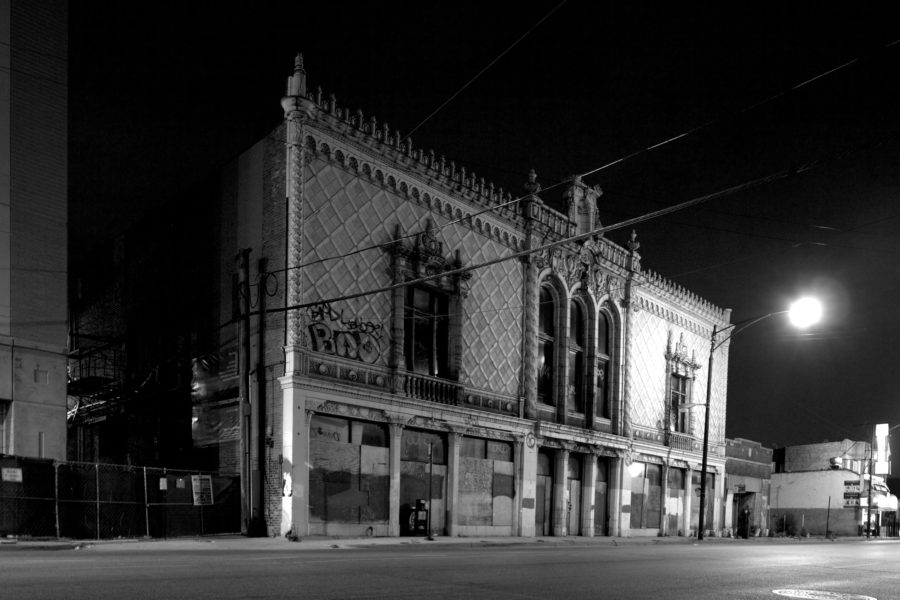
John Morris/Chicago Patterns
References and Further Reading
- A Palace of Pleasure for 1920s Chicago: The Pioneer Arcade (John D. Cramer)
- Humboldt Park Senior Housing Sprouts Over The Winter (Curbed)
- North and Pulaski Historical Society (Facebook)
- The Rise and Fall of Professional Bowling (Priceonomics)
- Landmark Nomination for Pioneer Bank (City of Chicago, PDF)
- Hispanic Housing Development Corporation


I spent a lost childhood in the pool hall, up until I got drafted into the Army in July 1966. The owner in those days was John Jay, managed by partners Bill and Mel.
Has anybody mentioned the ping pong room in the back? We use to rent the table so we could run our infrequent dice games.
The crowd that hung out there was as young as sixtten all the way up to some mid-eighty year-olds. A rather strange collection of characters that were all friendly.
I don’t even want to think of the number of parking tickets I received in front of the old place.
Thanks for a great piece. What a beautiful old building. What a great history. I hope someone will restore it to its grandeur.
Where can I get an application for s one bedroom
One correction, don’t you mean southEAST corner for the Woolworth’s fire? Southwest would be where the New Appollo and Rainbow is, and thus across the street from the Arcade. I walked around that area 5 years ago and was impressed by all the buildings at that intersection.
Brianbobcat, you are correct, it is southeast. Thank you for pointing out the mistake, I have corrected it in the article.
I remember that intersection very well. As a child, I was kind of sickly, and had to make weekly visits to our family doctor, Dr. W. Francis Jacobs, in his office over the old Tiffin Theater. My parents had originally lived in the area, on the 1800 block of N. Keystone, but when my mother’s parents retired and bought a house out in Schorsch Village right after I was born, my grandfather bought the house next door for my parents a few months later. My dad’s family, however, all lived near Armitage and Lowell, and we still went to that neighborhood often. I remember that under the Tiffin there was a paint store that also sold model car kits, and after a particularly rough illness, I remember my mother taking me in there buying me a model of a brand new 1959 Edsel Corsair convertible. We used to also go to Woolworth’s for lunch after the doctor’s appointment, or if it were later, to DeMar’s or Ferndell restaurant. As my dad grew up in the neighborhood, he explained to me that the building that was just north of the alley, on the east side of Pulaski, used to be the original Pioneer Bank building and it was moved to that site when the current building on the northwest corner was built. I remember getting my shoes along there, Ursin Shoes?, and there was a drug store whose name escapes me on the south side of North Avenue where we used to get prescriptions filled. I remember them more for the cherry Cokes we used to get. My dad’s cousin had a fresh chicken store on the north side of North Avenue, near Keeler, and we used to refer to him as “Chicken John” in our family. I don’t, however, remember meeting him. And of course, I remember the trolley buses that used to serve both Pulaski and North Avenue, and especially liked a drizzly day where the trolleys would spark when crossing the other trolley line in the intersection.
Just stumbled upon this site – reading comments brings back numerous memories! I grew up in this area (North Ave & Lawndale Ave) back in 1940s-50s. Last time in Chicago was 1963. In reference to the Woolworth’s fire – happened long after I was gone. Woolworth’s was on the southeast side of North Ave, east of Pulaski. On the very corner where Woolworth’s stood was a newsstand/drug store. On the southwest corner was S.S. Kresge (Woolworth’s chief competitor). Pioneer Bank – used to bank there! However, am not familiar with Pioneer Arcade, given the address. I remember a burned out building (former Apollo Theater) just south of North Ave on the west side of Pulaski. Believe someone finally purchased the site and turned it into a grocery store. Lots of memories of the “Crawford shopping district” which has long disappeared and/or changed from what it was in the 1940-60 era.
Do any inside pictures exist of the Pioneer Arcade and Bowl, from years ago? I’d sure love to see them, but I guess whatever very few inside photos that exist of this place just haven’t yet been scanned and posted online, and are hiding in someone’s photo collection? Who knows.
The only photo evidence of my favorite teen-age church (the pool hall) exist in my 71 year old mind. There are a few glimpses in the movie “Color of Money” with Paul Newman and Tom Cruise. I was told by one of the co-owners, Mel, that during the 1920’s it was one of the most exclusive in Chi-town. A vivid memory is that you could not touch the ceiling with cue in hand while standing on top of a table. Place had that plaster bric-a-brac scattered through out the room. An interesting note is that there was only one bathroom ……. and it was not female friendly.
can I rent it or buy the place call me 773-372-7565
I lived on the 1600 block of Kedvale near Wabansia. Loved the neighborhood it was during the 50s and 60s, everything within walking distance. I tried to think of all the stores between Keeler to just past Pulaski. The bakeries Hoffmans and Roesers, Hardings meats, Serrellis Italian beef, Ursins shoes,Osh Kosh clothing, Betty shop, Crawfords Dept. store, Pioneer bank,Mages sporting goods So much, so handy. To bad about what it looks like now. I live in California now and it breaks my heart to see that neighborhood now.